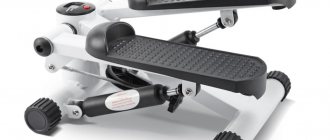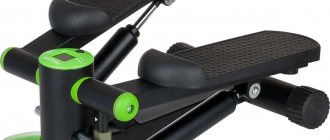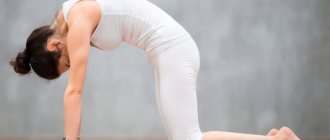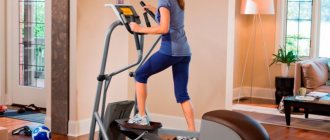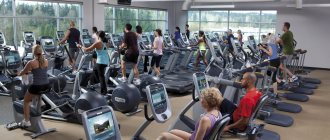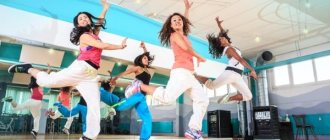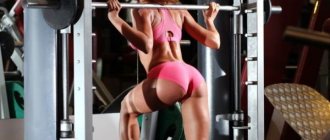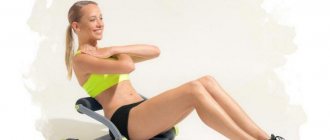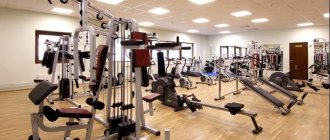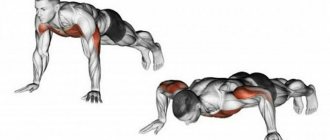A lot has been said about the fact that walking is one of the most useful and (most importantly!) activities accessible at any age. What could be more useful? Only walking up the stairs. It is successfully imitated by a stepper.
- What is a stepper for?
- What muscles can be developed using this simulator?
- Are there any contraindications to using it?
We will tell you about this and much more on this page, where novice “conquerors of physical activity” can learn as much useful information as possible.
What muscles work on the stepper?
The main work is aimed at the muscles of the legs, buttocks and lower legs. When performing the movement, the quadriceps and biceps femoris muscles are activated, as well as the adductors. With the correct position of the foot, the gluteal and calf muscles are exposed to load. static load if you train on the classic model.
If you train on a rotary climber, you can additionally engage the oblique abdominal muscles and deep spinal stabilizer muscles. In models with expanders, you can work out all the muscles of the shoulder girdle, performing swings for the deltoids, as well as flexion and extension of the arms for the biceps and triceps.
How to avoid mistakes and increase training efficiency? Five tips
- 1. Exercise in sportswear and proper shoes.
Avoid training barefoot or wearing thin-soled sneakers. The best option for effective exercise is sneakers. - 2. Install the machine correctly.
It should be located on a flat surface; It is necessary to organize free space within half a meter on all sides. Do not change the angle of the stepper by placing various objects under it for additional stability. - 3. Watch your foot position.
It should rest completely on the pedal and not hang beyond it. - 4. Follow the three main phases of training.
Start with a 5-10 minute warm-up; proceed to the main phase of training, with a consistent increase in intensity; end with a relaxation phase - leisurely walking for the last 5-7 minutes of the workout and stretching exercises. - 5. Monitor your pulse and breathing.
The appearance of shortness of breath or exceeding the peak heart rate (see below) are signs of critical loads that require a reduction in training intensity.
Advantages and disadvantages
Benefits of a stepper
- Strengthens the cardiovascular system.
- Increases the body's endurance.
- Increases the tone of all muscles of the body.
- Helps reduce weight, reduce subcutaneous fat and body volume.
- Safe for training at any age, at any body weight.
- Does not overload joints and spine.
- Suitable for training during rehabilitation after injuries.
Contraindications and disadvantages
- Exercise is contraindicated in case of heart disease or high blood pressure.
- Most models for home use are unable to support weights exceeding 100 kg.
- Some models do not provide adequate resistance to obtain the required load.
- One of the disadvantages may be the lack of support for the arms, which provides the load in only one position.
Duration of training
If a stepper exercise is performed after strength training, then the duration of walking can be limited to 20 minutes. The fact is that the body is already warmed up, which means aerobic exercise will immediately begin to affect subcutaneous fat.
If a cardio session on a stepper is performed separately from other activities, it should last 1 hour. During the first 40 minutes, the body will warm up and accelerate metabolic processes, and the next 20 will begin to burn through the fat layer.
“Entering” and “exiting” into a cardio session on a stepper should be smooth. Without a gradual increase and decrease in load, the body will perceive the training as stress, which means that the burning of subcutaneous fat will not start.
As a rule, one intense activity can burn up to 500 kcal. But for weight loss to be effective, the device should be used at least 4-5 times a week. It is recommended to combine walking on a stepper with strength training and low-carbohydrate nutrition.
What types of steppers are there?
According to the load system, steppers are divided into 2 types:
- Mechanical - the load is created by the user’s movements due to the hydraulic resistance of the cylinders. These steppers are inexpensive and also have displays that show time, number of steps and calorie counts. Models come with or without handles (mini-steppers), expanders to increase the load on the shoulder girdle. These models are suitable for training at home.
- Electromagnetic - the load is created by magnetic resistance. These models are professional exercise equipment designed for fitness clubs. The dimensions and cost of simulators are several times higher than mechanical ones. The exercise machines are equipped with a display that displays time, steps, and calorie consumption. The program also creates an individual load in which you can set your own parameters - gender, weight, age. Such simulators contain several levels of loads and types of programs for muscle tone, weight loss and strengthening of the cardiovascular system.
Depending on the type of movement and principle of operation, the following types are distinguished:
- Classic. Mechanical or electromagnetic steppers of various sizes, simulating classic stair climbing.
- Mini steppers. The most compact models on the market, specifically designed for home workouts. Such simulators may include only pedals, or additional handles for support and expanders. There are also several types:
- with expanders - the design with expanders is designed to load the muscles of the shoulder girdle; they can also have a display showing the duration of the workout and the number of steps;
- balancing - such a simulator has a pedal travel that depends on the user’s efforts; the movement of the simulator occurs due to rolling from foot to foot. Thus, coordination is additionally trained.
- Rotary with rotating handles. The exercise machines are designed for additional training of the abdominal and lower back muscles, when performing side crunches (twists). Designed for home use.
- Stairs. Modern professional models of mini escalators are specially designed for fitness clubs. Such state-of-the-art simulators simulate climbing exactly like an escalator, and accordingly, they cost much more than their predecessors. Equipped with a huge amount of functionality, from displaying any program of various levels to multimedia and entertainment applications.
Choosing a stepper for home
To choose the right walking machine, of course, it is better to consult with a fitness specialist. Much is determined by financial capabilities. It is also very important to consider the available space in your home.
If your goals are purely practical: remove fat, lose weight, the simplest exercise machine will do. If you want to approach the issue of training more professionally, and the funds allow, you can buy an expensive model that will allow you to set up different modes and monitor various vital signs. They will show how many steps you took and how many calories you burned.
If you want to get by with a minimum set, buy a simple or rotary hydraulic trainer for walking in place - a stepper. If there is not enough space in your apartment, choose a mini-stepper. These models are comfortable and functional, and at the same time they are suitable for losing weight and training muscles. The cost of such equipment varies between 1800-20000 rubles.
How to exercise on a stepper for weight loss
The optimal training duration is 40-60 minutes.
- If you are training on a machine with a hydraulic system , select a sufficient level of resistance at which the muscles receive a noticeable load, but are able to maintain a sufficient pace. For these workouts, you can use resistance bands or light dumbbells to ensure multiple repetitions on all muscle groups.
- For training on electromagnetic simulators , choose interval load in fat burning mode; for this, the program itself will select an individual load and heart rate zone depending on your personal parameters (weight, gender, age).
Techniques for increasing the load on the buttocks
In order to emphasize the load on the buttocks, professional exercise machines are needed that provide support in various positions. Such models provide horizontal or inclined handles on which you can place your forearms. Thus, tilting the body will provide greater load on the buttocks , excluding the help of the lumbar muscles. The resistance load can be more intense and the pace slower.
Safety regulations
You need to approach training on a stepper very carefully if you have problems with your knee joints. It is important to place your foot on the pedal correctly - completely, without lifting your heel, and do not bring your knees inward. Also, do not lean your body forward and distribute your body weight evenly between your legs. To keep your knees safe, walk smoothly, easily, without pushing hard or pushing off the pedal suddenly.
“There are symptoms that do not cause us much trouble, but may indicate wear and tear of the articular cartilage,” warns Olga Novikova. — This is discomfort in the legs at the end of the day, heaviness in the knees, crunching when squatting, bending the knees, nagging pain in the knees and their reaction to changing weather. If you notice any of the above, it is better to consult a doctor without causing severe pain.” Also keep in mind that the stepper is not recommended for varicose veins.
Main manufacturers
HouseFit
The HS-5027 model is a classic stepper for the home, and the K0710A mini-stepper from an American manufacturer with a hydraulic loading system is designed specifically for home use and runs on batteries. Withstands maximum load up to 100 kg. Equipped with a computer showing workout time, number of steps and calorie consumption.
Johnson S8000
The brand offers professional electromagnetic exercise equipment for gyms. The model has independent pedal travel, providing biomechanical correction of movements. Includes functions for changing speed, programs and loads. Withstands up to 180 kg.
Hop-Sport HS-40S
A classic stepper with a mechanical loading system with handles and expanders. The Polish manufacturer has developed a home line of exercise equipment that can withstand loads of up to 100 kg. The display of the simulator shows the distance, number of steps and duration of the workout.
Pulse Fusion Line 220G
The professional line of electromagnetic steppers with independent pedal stroke offers a classic model with a color display, heart rate sensors and load indicators. Compatible with iPod and Polar.
Bradex Cardio Twister
Rotary stepper model with seven load levels for home use. Withstands up to 110 kg. Soft grip rotating handle, non-slip pedals, durable construction.
Comparison with other cardio machines
The fitness industry offers athletes a variety of leg exercise equipment. Let's look at the main differences between steppers and other popular devices.
Treadmill
The machine is designed to warm up before the main part of the training, strengthen the cardiovascular system and reduce body fat.
The advantage over a stepper is that it consumes more calories in the same period of time. This is due to the intense work of the whole body when running.
The electronic track has a number of disadvantages: increased noise, large size and shock load on the knee joints and spine.
The stepper takes up little space, is practically silent and does not injure the musculoskeletal system.
Exercise bike
The device simulates the pedaling of a bicycle. Designed for cardio exercise, burning subcutaneous fat, and strengthening the lower body.
The advantages include high-quality training of the thighs and legs, as well as increased calorie consumption.
The disadvantages are the lack of stress on the upper body.
A stepper differs from a bicycle machine in that it trains the muscles of the legs and buttocks, develops stabilizers, and also strengthens the arms and shoulders by incorporating rubber expanders into the work.
Orbitrack or elliptical trainer
The simulator looks like a Nordic walking stepper. The difference is that its pedals do not move up and down, but along an elliptical path.
The range of movement of an athlete on an orbit track is much wider than on a stepper. This allows you to simultaneously use a large number of muscles and thereby increase calorie expenditure.
The disadvantages of the ellipsoid are its rather high cost and large size.
A simple stepper, as a home exercise machine, is more preferable because it takes up less space, is affordable, and is effective in losing weight and strengthening the lower extremities.
Operating principle of the device
And to move on to the topic of what muscle groups this simulator works on, let’s first find out what it is.
A stepper is one of the types of cardio equipment. The mechanics of movement on it are reminiscent of climbing stairs. Therefore, we can safely say that exercises on a stepper are physiological and natural, and the principle of its operation is simple and understandable.
The device usually does not take up much space, so it is great for home workouts. Mini models are considered the most compact options. This is an ideal solution for owners of small apartments, as well as those who want to exercise even in the office or in the country.
TRX functional training loops
TRX (total body resistance exercise) are nylon slings with palm handles and foot loops. The exercise machine is mounted on a horizontal bar, a rack, or even an ordinary door and allows you to perform many exercises with your body weight: various push-ups and pull-ups, flyes, squats, lunges, folds and abdominal crunches.
Everything is done in an unstable environment - you have to make extra efforts to maintain balance. This increases the complexity of the movements and the expenditure of calories, pumps up the muscles, sense of balance and coordination.
Also, with exercises on loops, you can create cardio complexes for pumping endurance.
Rowing machine
A rowing machine burns on average about 600 kcal per hour - more A comparison of energy expenditure during rowing and cycling ergometry than when exercising on an exercise bike. Loads the shoulders, back muscles, biceps and chest, hips, buttocks and abs, pumps up the grip, strengthens the wrists.
No shock to the knees or back, minimal risk of injury. The exercise machine is perfect for people of any age, weight and fitness level.
How to choose an exercise machine for your home
The most inexpensive rowing machines are those with hydraulic cylinders. They have two handles, which simulates rowing in real conditions, but for effective training you need to master the rowing technique, otherwise it will be difficult to practice.
Cheap exercise machines of this type cost from 10 thousand rubles, do not have adjustments for a person’s height and often make a lot of noise due to the plastic seat rollers. The price of more expensive models can exceed 40 thousand rubles. Usually they provide several programs, all the necessary adjustments and a heart rate monitor.
For those new to rowing, it is best to try models with center thrust.
On these machines, you grab a handle attached to a cable with both hands and slide back into the seat.
If you are not going to set records and monitor your heart rate, but just want to burn calories and pump up muscles, choose cheap models with a magnetic load, which have a price of around 13 thousand rubles. Electromagnetic models starting from 30 thousand have ready-made programs and the ability to connect a cardio belt for accurate pulse determination.
For really hard and intense workouts, we can recommend an aerodynamic rowing machine. Such models are equipped with a movable fan, the blades of which create resistance: the harder you pull the handle, the more difficult it is to row. The simulator corresponds to work in real conditions as closely as possible, and therefore is used by professional athletes. However, it is not cheap - from 38 thousand rubles - and, in addition, it is very noisy.
If you want training like the professionals, but also a cool-looking machine, consider models with a water-type load. In them, resistance is created by blades moving in a container of water, which simulates the conditions of real rowing. Such simulators cost from 40 thousand if made of metal, and from 80 thousand if made of wood. The latter look amazingly stylish.
What to buy
Correct Nordic walking technique
Knowing the correct Nordic walking technique guarantees the greatest effect.
Basic rules of Nordic walking technique:
- Before starting the workout, you need to do a warm-up: bending over with and without poles, swinging your legs and arms.
- The sticks should be kept close to the body. The hands should be relaxed, practically not squeezing the handle.
- During the movement, one arm is bent at the elbow at an angle of 45 degrees and extended slightly forward. In this case, the stick corresponding to it is at an angle, and the other is directed back at the level of the pelvis in a slightly bent arm. The right hand moves with the left leg, the left hand with the right leg.
- The Nordic step is performed by rolling the foot from heel to toe.
- The head should be in line with the spine, while the body leans slightly forward.
- Breathing should be smooth and calm. At the beginning of the lesson you should breathe only through your nose, after increasing the pace you can exhale through your mouth.
- At the end of classes, you need to take a few deep breaths and perform exercises for the muscles of the back and legs. When you return home, it is recommended to take a warm bath - this will prevent muscle pain the next day.
